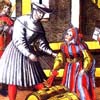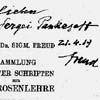
Special Collections
Special collections pertaining to Europe include personal libraries, illustrated books, collections of unusual provenance, and author, subject, or language collections. Of the hundreds of special collections in the Library of Congress, those that were seminal to large-scale collecting by the Library in a particular field deserve special mention. They include collections that are strictly European and those with a strong European component.
As noted earlier, the broad subject base of Jefferson's collection stamped the Library from the beginning as something more than an assemblage of law books for the use of legislators, although it did remain strictly a library for the use of the Congress for another fifty years. As with the burning of the Capitol in 1814, once again a fire triggered a significant advance in the development of the collections a half-century later. In 1866, the Smithsonian Institution's 40,000 volumes, chiefly in science and technology with a very strong European representation, were deposited at the Library of Congress following a fire at the Smithsonian the previous year, with the provision that "the public shall have access thereto for purposes of consultation." Besides providing a significant new subject dimension to the congressional collection, the Smithsonian deposit initiated the Library's program of exchanges with institutions abroad. At the time of its incorporation into the Library's collections in 1941, the deposit formed a separate collection of more than a half-million volumes, the major part of the Library's European holdings in science and technology. Today science and technology makes up 25 percent of the Library's general collections.
Occasionally the acquisition of a special collection marked a quantum leap in the Library's holdings on a single country. Thus the inventory of foreign books in the Report of the Librarian of Congress for the Fiscal Year Ending June 30, 1901 had given the Russian total as only 569 volumes, exclusive of the Smithsonian deposit. Six years later the purchase of the private collection of the Siberian merchant Gennadii Yudin brought a staggering total of 68,000 volumes of Russian-language materials to the Library. In the words of President Theodore Roosevelt, the Yudin collection "will give the Library of Congress preeminence in this particular field, not only in the United States, but as far as I know in the world generally outside of Russia; and this in a field not yet developed at all in America."
Like the Jefferson collection, the Yudin collection was broad-based and the finest private library in his country. It was a working library, but it also contained more than 4,000 rare items, including long runs of eighteenth-century periodicals that give the researcher an in-depth view of the intellectual movements and activities of the period. Yudin's library created the base upon which the present 700,000-volume Russian-language collection of the Library of Congress would be built.
In similar fashion, albeit on a considerably smaller scale, a significant addition to the Library's then modest Bulgarian collection was the purchase in 1949 of the Early Bulgarian Imprint Collection from the bibliophile Todor Plochev. These 650 books represent the best titles published during the Bulgarian Renaissance (1806-78), a time when publishing in the Bulgarian language in Bulgaria was forbidden under Ottoman rule. The Library's Bulgarian collection has since grown to approximately 40,000 volumes.
The nucleus of the Library's extensive collection of works on Portuguese history and literature emerged in 1927 and 1929 through the purchase of the Portuguese Manuscript Collection, with items dating from 1438 into the twentieth century, including books, manuscripts, and letters of diplomats. A special connection to South America are the 201 letters to or by Manoel de Cunha Menezes, captain general of Pernambuco and Bahia (1774-79).
The Library's considerable holdings in aeronautics were initiated by the acquisition in 1930 of the Tissandier Collection, relating to the history of aeronautics from 1776 to 1914. The collection was assembled by Albert, Gaston, and Paul Tissandier, balloonists and aeronautical historians, and it contained, according to Librarian of Congress Herbert Putnam (tenure 1899-1939), "approximately all the worth-while aeronautics literature published in France up to 1900." This acquisition accompanied the creation in the Library of a Division of Aeronautics in 1930 and an aggressive acquisitions program that brought gifts from individuals and organizations prominent in American aeronautics.
In a totally different vein, magic, illusion, spiritualism, and magical apparatus--much of it with a European flavor--are represented in two special collections. Books numbering nearly 4,000 volumes as well as prints, playbills, pamphlets, scrapbooks, and periodicals on magic, witchcraft, demonology, psychic phenomena, and spiritualism formed the bequest of Harry Houdini, the son of a Budapest rabbi, who became a world-renowned magician. The Library received this collection in 1927, a year after Houdini's death. Houdini's bequest was followed by the 10,000-item collection of publications and pictorial material relating to magic and magical apparatus presented to the Library in 1955 by John J. and Hanna M. McManus and Morris N. and Chesley V. Young. This collection contains works, inter alia, on conjuring, ventriloquism, fortune-telling, spiritualism, witchcraft, hypnotism, mind reading, and explanations of magicians' tricks.
The Library's special collections are not confined to written matter. The Archive of Hispanic Literature on Tape comprises recordings of prominent authors of Spanish and Portuguese works in Europe and America. The archive was begun in 1942 and now consists of more than 600 readings of writers that include seven Nobel prize winners, three of them from Spain. A similar program, the Archive of World Literature on Tape, was begun in 1977 to include those countries and languages not represented by the Archive of Hispanic Literature on Tape. For the next dozen years this program proved especially valuable for recording authors from the communist countries of Europe who, while they hesitated to record for the American audience in their own countries, felt at ease recording at the Library of Congress. Recordings of authors from the European democracies are also represented in this collection.
The special-format collections also include glass-plate negatives in the Prokudin-Gorskii and Detroit Publishing Company collections. Sergei Mikhailovich Prokudin-Gorskii, Russian pioneer in color photography and "photographer to the tsar," photographed artworks, architecture, industry, topography, individuals, and daily life in both European and Asiatic Russia, mostly between 1909 and 1911. The Library of Congress purchased this collection of 1,900 negatives in 1948. Contact prints, made from the negatives and mounted in fifteen albums, are available for examination by the reader. The Detroit Publishing Company Collections of 18,500 glass negatives and 22,000 photoprints depict historic sites, natural landmarks, industry, sports activities, and buildings in America and in Europe in the period 1898-1924. There is strong representation of Austria-Hungary, Russia, and the Balkans, as well as more conventional scenes of Western and Southern Europe.
 Children near Belozersk.
One of a collection of 2,500 color photographs, taken between 1906 and
1912 by Russian photographer Sergei Prokudin-Gorskii, which give intimate
glimpses into the life of late imperial Russia. (Prokudin-Gorskii
Collection, Prints and Photographs
Division)
Children near Belozersk.
One of a collection of 2,500 color photographs, taken between 1906 and
1912 by Russian photographer Sergei Prokudin-Gorskii, which give intimate
glimpses into the life of late imperial Russia. (Prokudin-Gorskii
Collection, Prints and Photographs
Division)
The Otto Vollbehr collection of more than 3,000 fifteenth-century incunabula and early printed books acquired by an Act of Congress in 1930 taken together with the Lessing J. Rosenwald gift to the Library of Congress (1943-75) of more than 2,600 illustrated books from the fifteenth to the twentieth centuries, and the Wilhelm Schreiber collection (1929) of more than 20,000 book illustrations dating from the fifteenth through the eighteenth centuries make the Library of Congress a major source of research on the history of European printing and the book arts.
 Theuerdank (Augsburg, 1517),
illustration no. 60. This work, which presents a loosely disguised
portrait of Emperor Maximillian , was the first to use Fraktur before
it became the standard German letterform. Included are many scenes of
everyday life in the sixteenth century. (Lessing
J. Rosenwald Collection, Rare
Book and Special Collections Division)
Theuerdank (Augsburg, 1517),
illustration no. 60. This work, which presents a loosely disguised
portrait of Emperor Maximillian , was the first to use Fraktur before
it became the standard German letterform. Included are many scenes of
everyday life in the sixteenth century. (Lessing
J. Rosenwald Collection, Rare
Book and Special Collections Division)
Collections pertaining to political events include the German Captured Documents collection, consisting of 350,000 documents from the interwar and World War II period, including records of the treatment of the territories occupied by German forces during the war. A particular interest of Librarian of Congress James H. Billington (Librarian since 1987), the Soviet Independent Press collection amounts to some 20,000 issues of 3,000 serial titles, representing every political shade and faction from monarchist to extreme left, published during the period of exuberance between the promulgation of more liberal press laws and the demise of the Soviet Union at the end of 1991.
Notable collections devoted to individual European personalities include, for example, 500 volumes assembled by the Law Library of the writings and various editions of the great English jurist William Blackstone, whose Commentaries on the Laws of England was the first systematic treatise on the principles and decisions of English common law. Similarly, beginning in the 1950s the Library began to form an important collection of the papers and early editions of the works of Sigmund Freud, the founder of psychoanalysis. In addition to an extensive collection of Freud's manuscripts and correspondence--among them, the manuscripts of the case of Sergius Pankejeff, the "Wolfman"--the Library holds a number of presentation copies from Freud's library. Today the collection amounts to some 80,000 manuscript pieces and several hundred books. A third such collection on an individual personality came to the Library when Danish actor Jean Hersholt and Mrs. Hersholt donated their comprehensive collection of works by and about the author Hans Christian Andersen. The gift, which included first editions, manuscripts, letters, presentation copies, and pictorial material as well as translations, constitutes the most outstanding Andersen collection outside Denmark.
 Sigmund
Freud. Sammlung kleiner S chriften zur Neurosenlehre (Leipzig,
Vienna, 1906). In 1919, Freud signed and presented this 1906 edition
to Sergius Pankejeff, the "Wolfman." (Freud Collection, Rare
Book and Special Collections Division)
Sigmund
Freud. Sammlung kleiner S chriften zur Neurosenlehre (Leipzig,
Vienna, 1906). In 1919, Freud signed and presented this 1906 edition
to Sergius Pankejeff, the "Wolfman." (Freud Collection, Rare
Book and Special Collections Division)
Library of Congress ( September 21, 2010 ) Ask a Librarian |
LC Home Page | Search the LC Catalog | European Reading Room |